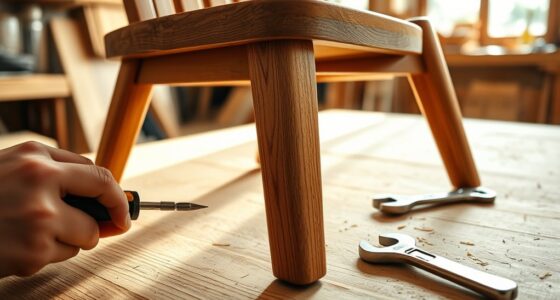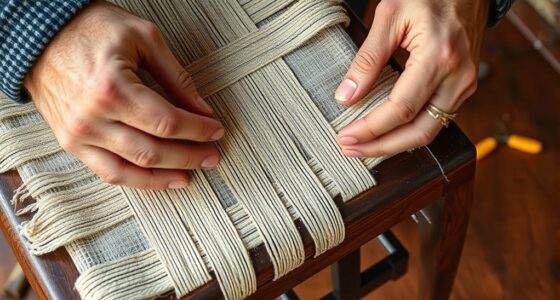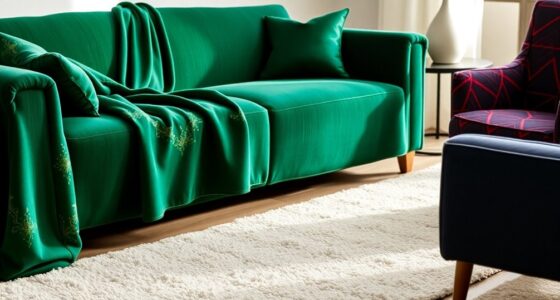To achieve DIY slipcovers that really fit, start by carefully measuring your furniture, noting all curves and angles. Choose high-quality, durable fabrics that match your style and are easy to clean. Create precise patterns, cut your fabric accurately, and sew with consistent seam allowances for a professional look. Install your slipcover snugly, using fasteners or elastic for stability. Keep adjusting and maintaining it over time for the best fit—stay with us to learn more!
Key Takeaways
- Take precise measurements of furniture, including curves and angles, and create detailed patterns with seam allowances for a perfect fit.
- Select durable, tightly woven, and stretchable fabrics suited for comfort, longevity, and style, ensuring they resist fading and wear.
- Sew carefully with sharp tools, align grainlines, and finish edges to ensure clean, snug-fitting slipcovers that stay in place.
- Use fasteners, elastic bands, or ties during installation to secure the slipcover and prevent shifting over time.
- Regularly inspect, clean, and adjust fasteners to maintain fit, appearance, and durability for long-lasting, well-fitting slipcovers.
Measuring Your Furniture for a Perfect Fit

Before you start sewing your slipcovers, it’s essential to measure your furniture accurately. Precise measurements ensure a snug, professional fit. Use a tape measure to record the length, width, and height of each piece of furniture, including armrests and cushions. Take note of any curves or angles that might affect how the slipcover fits. When considering fabric selection, choose a material that complements your room’s style and coordinates well with your existing decor. Proper measurements prevent excess fabric or gaps, making your slipcovers look neat and polished. Double-check your measurements before purchasing fabric or cutting patterns. Additionally, understanding the benefits of raw food can inspire you to select healthier, more natural fabrics that are sustainable and eco-friendly. The right fabric and careful measurements work together to create slipcovers that are both functional and visually appealing, giving your furniture a fresh, tailored look.
Choosing the Right Fabric for Comfort and Durability
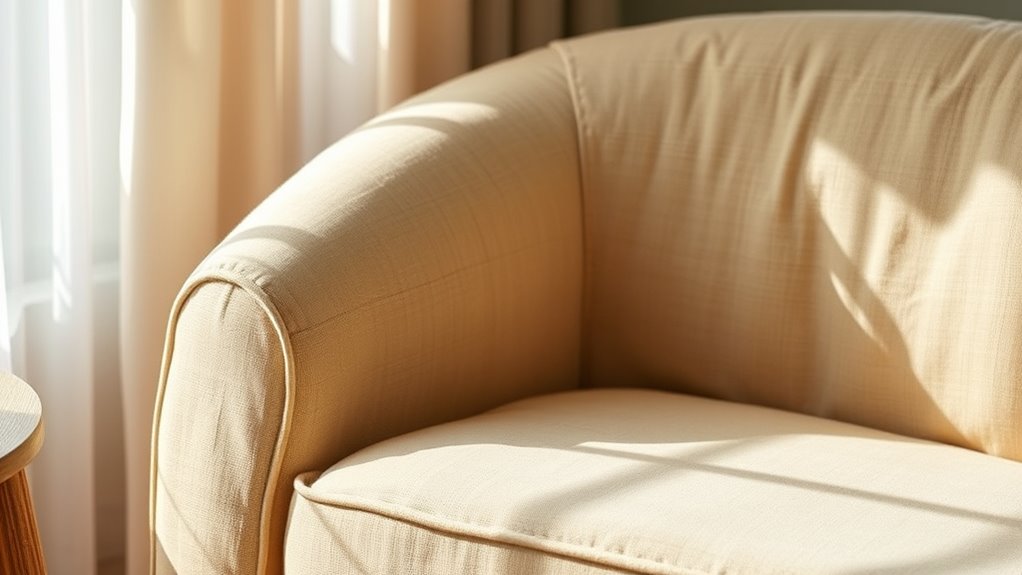
Selecting the right fabric is essential for ensuring your slipcovers are both comfortable and long-lasting. You want material that offers good fabric breathability to keep you comfortable and withstand daily use. Consider these factors:
Choosing breathable, durable fabrics ensures comfortable, long-lasting slipcovers that withstand daily use.
- Fabric breathability: Choose natural fibers like cotton or linen for airflow and comfort.
- Colorfastness: Opt for fabrics that resist fading when exposed to sunlight or cleaning.
- Durability: Look for tightly woven fabrics that resist tears and wear over time.
- Maintenance: Pick fabrics that are easy to clean and maintain without losing quality.
- Embracing imperfections: Remember that embracing imperfections can be part of the creative process and help you achieve a more authentic, personalized look.
Creating a Pattern: Step-by-Step Guide
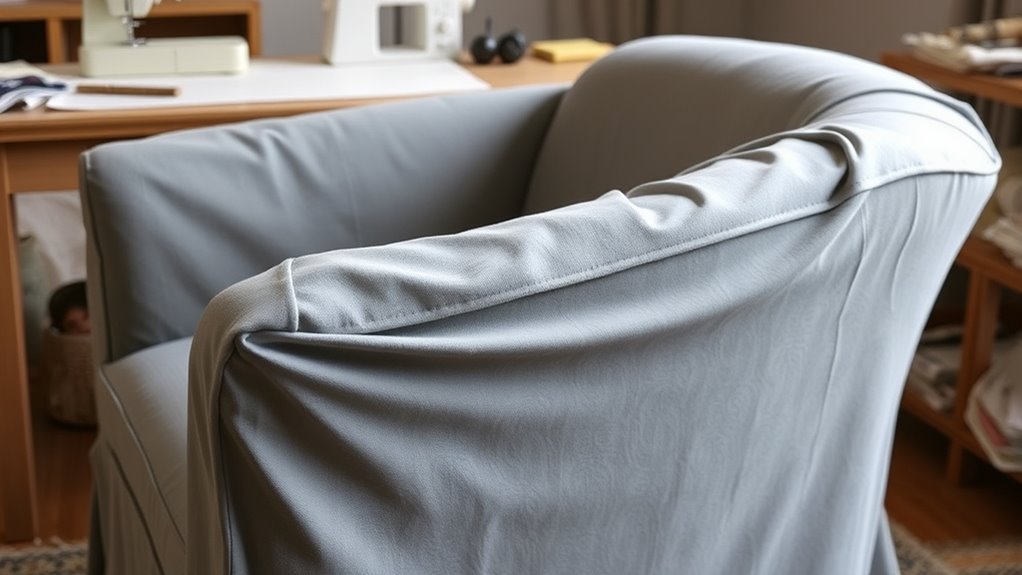
Creating a pattern is a crucial step that guarantees your slipcover will fit your furniture perfectly. To start, measure your furniture carefully, noting dimensions like height, width, and depth. Choose a fabric that balances durability and ease of handling; sturdy fabric ensures your pattern holds over time. Once you have your measurements, sketch your pattern, adding seam allowances for a clean fit. Use the table below to organize your measurements:
| Part | Measurement | Notes |
|---|---|---|
| Back Panel | ___ inches | Add extra for seam allowance |
| Seat Area | ___ inches | Consider fabric stretch |
| Armrests | ___ inches | Match armrest shape |
| Front Panel | ___ inches | Include hem allowance |
| Skirt or Bottom | ___ inches | For slipcover length |
This process helps you create a durable, well-fitting pattern. Additionally, understanding material choice can influence the final look and longevity of your slipcover.
Cutting and Sewing Your Slipcover With Precision
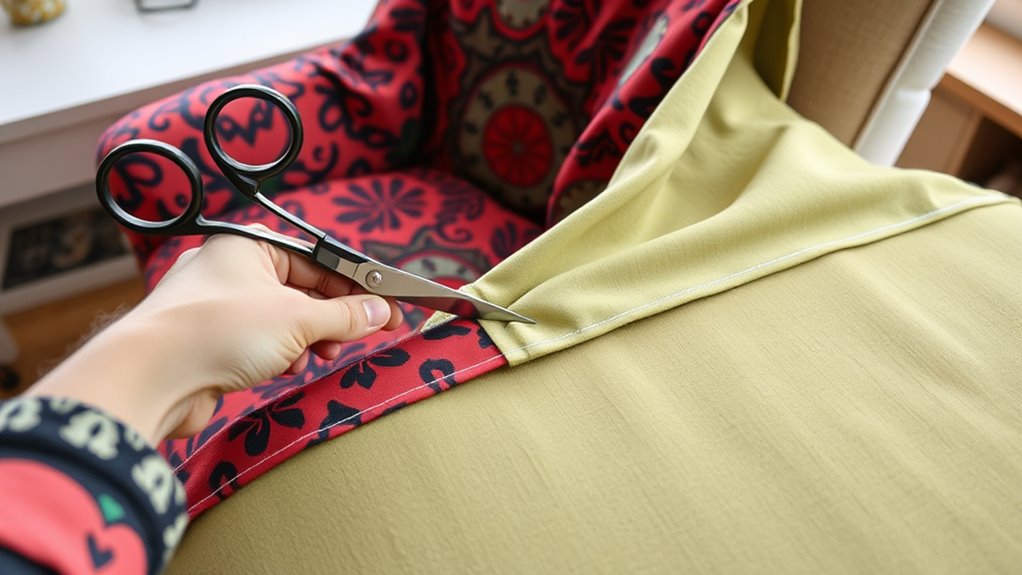
To guarantee your slipcover fits perfectly, it’s essential to cut and sew with precision. First, double-check your pattern measurements before cutting. Next, follow these key tips:
- Use sharp scissors or rotary cutters for clean edges, especially when handling fabric dyeing or decorative embellishments.
- Pin fabric carefully, aligning grainlines to prevent distortion during sewing.
- Sew slowly and accurately, maintaining consistent seam allowances.
- Finish raw edges to prevent fraying, ensuring durability for decorative details.
- Incorporate proper fabric handling techniques to avoid stretching or misshaping during construction. Precision in cutting and sewing helps your slipcover look professional and accommodates fabric dyeing or embellishments seamlessly. Pay close attention to details, especially when adding decorative touches, so everything lines up perfectly. This careful approach guarantees a polished, tailored fit that enhances your furniture’s style.
Installing the Slipcover for a Tailored Look
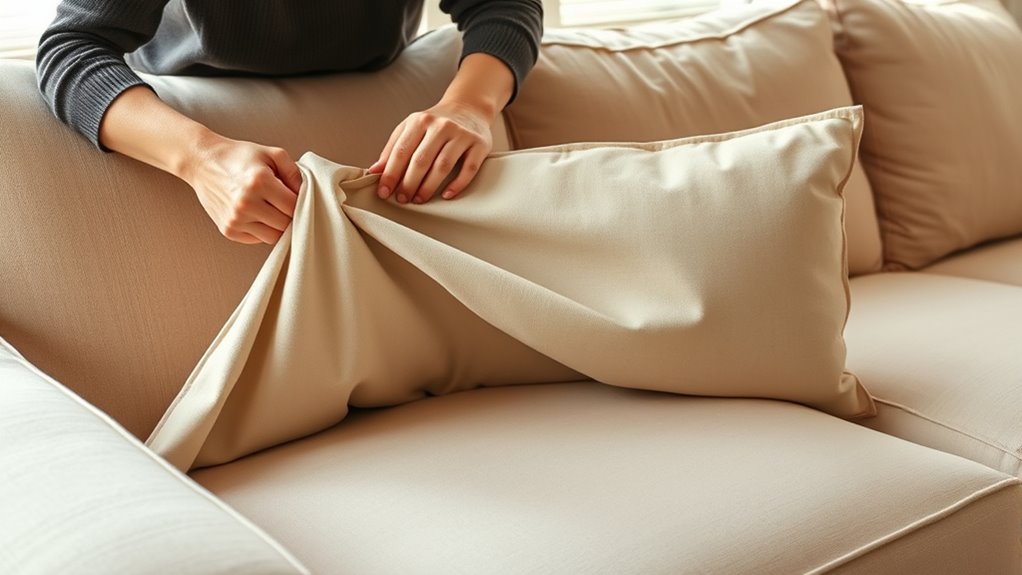
To achieve a polished, tailored look, focus on aligning your fabric precisely before securing it. Use secure fastening techniques like upholstery pins or staples to keep the slipcover in place. Taking your time with these steps guarantees a neat, professional finish. Additionally, scheduling your project during off-peak hours can help you work more efficiently and avoid distractions.
Precise Fabric Alignment
Achieving a polished, tailored look with your slipcover hinges on precise fabric alignment. To guarantee a perfect fit, focus on these key steps:
- Check fabric stretch, making sure the material isn’t overstretched, which can cause puckering.
- Align seams carefully, matching edge stitches to maintain symmetry.
- Smooth fabric as you pull it over the furniture, avoiding wrinkles or bubbles.
- Use pins or clips to hold fabric in place, especially along the seams, before securing it permanently.
- Pay attention to fabric materials, as different fabrics have varying stretch and drape qualities that impact how well the slipcover fits.
Proper seam alignment is essential for a professional look, so take your time. Adjust the fabric as needed, ensuring it lays flat and smooth. Precise fabric alignment makes your slipcover look custom-made, not homemade.
Secure Fastening Techniques
Once you’ve aligned your slipcover fabric, securing it firmly in place is essential for a polished, tailored appearance. Velcro fasteners are a quick, effective way to keep the slipcover snug around the furniture. Attach strips along the edges or underneath for a seamless look that holds the fabric in position. Elastic bands are another reliable option; sew or staple them into the slipcover’s hem or corners to create tension and prevent shifting. For added security, combine velcro fasteners with elastic bands, especially on larger pieces. Always ensure the fasteners are hidden or discreetly placed to maintain a clean, professional finish. These techniques help your slipcover stay in place, giving your furniture a sleek, custom-fit look that lasts. Additionally, choosing durable fasteners ensures long-term performance, much like the resale value of electric bikes remains strong due to quality components.
Tips for Adjusting and Maintaining Your Slipcover
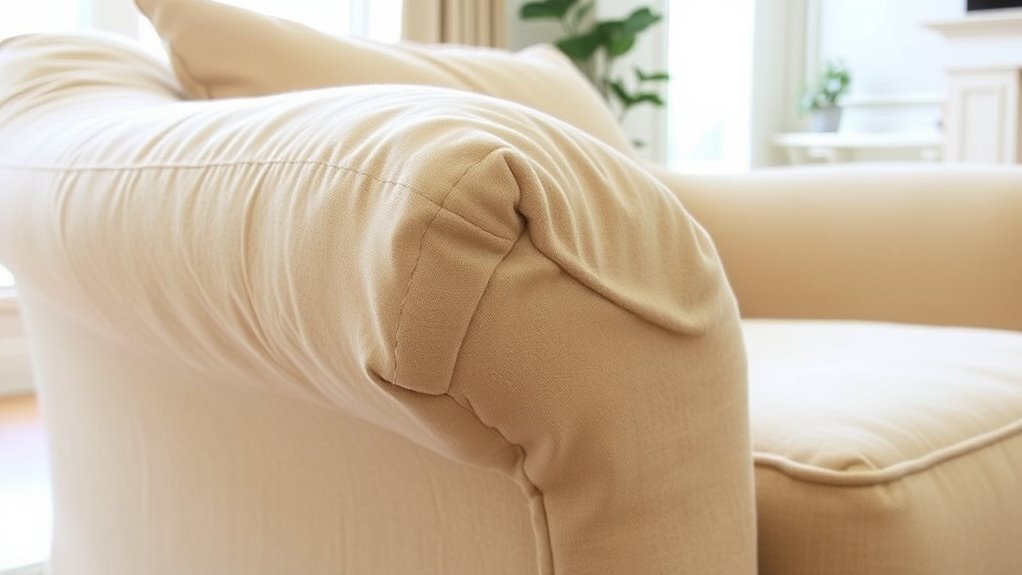
To keep your slipcover fitting perfectly, make sure to secure it tightly and adjust as needed over time. Regular cleaning will help maintain its appearance and prolong its lifespan. Keep these tips in mind to guarantee your slipcover stays looking fresh and well-fitted. Additionally, understanding resources and tools available for home maintenance can help you find the best products to care for your slipcover.
Securing the Fit
Securing your slipcover properly is essential to keep it in place and maintain a neat appearance. To achieve a secure fit, consider these tips:
- Use elastic bands or drawstrings at the edges to hold the slipcover snugly.
- Tuck excess fabric into crevices, especially around armrests and cushions.
- Attach decorative accents like buttons or ribbons to hide fasteners and add style.
- Ensure your slipcover’s color coordination matches your furniture and decor, creating a cohesive look.
- Opt for slipcovers made from high-quality fabric that offer better stretch and durability over time.
These steps help prevent slipping or shifting over time. Regularly checking and adjusting fasteners keeps your slipcover looking fresh. Incorporate decorative accents thoughtfully to enhance the overall aesthetic without compromising fit. A secure, well-maintained slipcover elevates your furniture’s style effortlessly.
Regular Cleaning Tips
Regular cleaning keeps your slipcover looking fresh and extends its lifespan. To maintain fabric care, wash your slipcover according to the manufacturer’s instructions, usually in cold water with gentle detergent. Regular vacuuming helps remove dust and debris that can wear down the fabric over time. When stains appear, act quickly with targeted stain removal techniques—blot, don’t rub, and use a fabric-safe stain remover. Always test cleaning products on a small, hidden area first to avoid discoloration. After washing, reshape the slipcover and allow it to air dry or tumble dry on low heat. Proper maintenance prevents dirt buildup and keeps your slipcover fitting smoothly. Using the right vacuum cleaner attachments can also help in maintaining your slipcover’s appearance and longevity. Consistent cleaning not only preserves its appearance but also ensures it stays comfortable and durable for years to come.
Troubleshooting Common Fit Issues
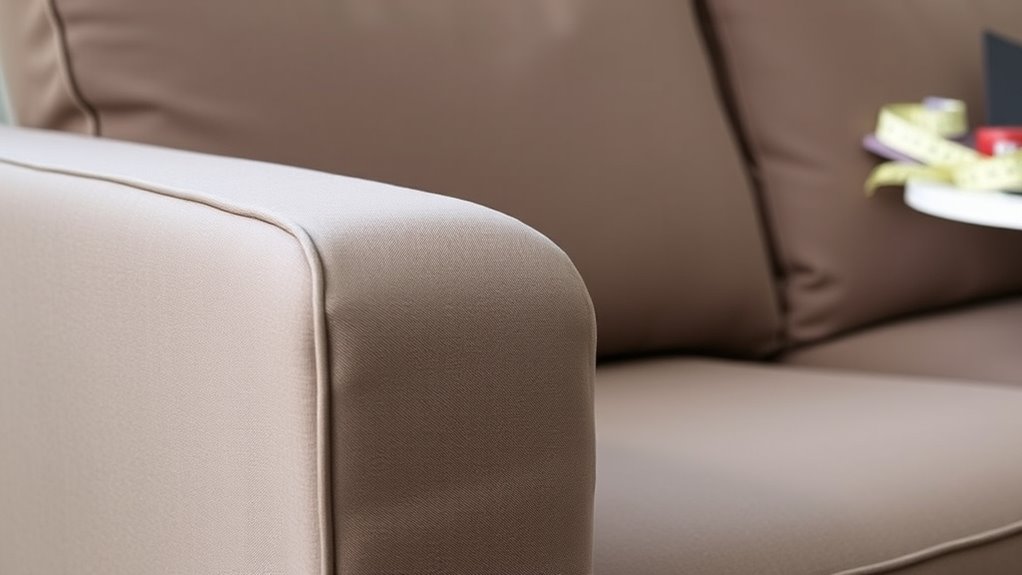
When slipcovers don’t fit quite right, it’s often due to mismatched dimensions or improper placement. To improve fit and guarantee fabric durability for slipcover longevity, consider these tips:
- Measure your furniture carefully before cutting or sewing.
- Adjust seams or darts to better contour the slipcover.
- Use stretchable fabrics for easier fitting and better durability.
- Secure edges with fasteners or ties to prevent shifting.
If your slipcover is too loose, try tightening the seams or adding elastic. For tight fits, gently stretch fabric in key areas during placement. Proper fit not only improves appearance but also preserves fabric durability, extending slipcover longevity. Taking these steps helps you troubleshoot common issues quickly and achieve a professional look.
Frequently Asked Questions
Can Slipcovers Be Machine Washed Without Damage?
You can machine wash slipcovers without damaging them if you follow proper fabric cleaning methods. Check the care label first to confirm slipcover durability, as some fabrics require gentle cycles or cold water. Use mild detergent and avoid bleach, which can weaken fibers. Washing correctly preserves the fit and appearance, making your slipcover last longer. Regular cleaning helps maintain their look and feel, keeping your furniture fresh and protected.
How Often Should I Replace My Slipcover for Optimal Fit?
You should replace your slipcover every 2 to 3 years for ideal fit and fabric longevity. Regular slipcover maintenance, like washing and spot cleaning, helps extend its life, but over time, fabric can stretch or fade, affecting the fit. Keep an eye on signs of wear or looseness, and don’t hesitate to replace it when needed. Doing so ensures your furniture stays looking fresh and well-fitted.
Are There Eco-Friendly Fabric Options for Slipcovers?
You’re probably wondering if eco-friendly fabrics exist for slipcovers. The good news is, many sustainable slipcover options use eco-friendly fabrics like organic cotton, hemp, linen, and bamboo, which are biodegradable and produced with fewer chemicals. By choosing these sustainable slipcover options, you’re making an environmentally conscious choice that reduces your carbon footprint while still getting a stylish, durable fit for your furniture.
Will Custom Slipcovers Fit Over Existing Cushions?
When considering whether custom slipcovers will fit over existing cushions, you need to focus on slipcover sizing and cushion compatibility. You measure your cushions carefully, compare those measurements to slipcover dimensions, and verify the fabric has enough stretch. You check for snugness, ease of installation, and how well the slipcover contours to your cushions. By paying attention to these details, you’ll guarantee a proper fit that enhances your furniture’s look and comfort.
How Do I Prevent Slipcovers From Slipping Off?
To prevent slipcovers from slipping off, you should use non-slip techniques like adding fabric grip or anti-slip pads underneath. Tuck the slipcover tightly into the seams and secure it with elastic bands or Velcro where possible. Stretch the fabric evenly and use furniture anchors if needed. These methods guarantee your slipcover stays in place, providing a neat, tailored look without constant readjustments.
Conclusion
With the right measurements and fabric choices, you can create slipcovers that fit perfectly and last for years. Did you know that DIY slipcovers can save you up to 50% compared to professional reupholstery? By following these simple steps, you’ll enjoy a custom look without breaking the bank. Keep adjusting and maintaining your slipcover, and you’ll transform your furniture into a stylish, comfortable centerpiece that truly reflects your personal style.


